Combat aircraft. Po-2 in the German manner
So our Po-2, throughout the war, was engaged in a variety of things: bombing, taking out the wounded, dropping cargo to the partisans and those surrounded, scouting the weather, delivering mail and orders, and in general, it was an airplane for all occasions.
The Germans had about the same irreplaceable thing. In general, no army in the world could operate successfully without communications aircraft. Such were the times, without the military Internet and long-distance communication systems.
In general, where the Wehrmacht was, one could meet our hero there, from the sands of North Africa to the cold fjords of Norway.
The Fieseler Fi.156 "Storch" turned out to be a very successful machine, very lightweight, but possessing simply unique flight characteristics, the main of which was the ability to sit on a minimum-size platform and take off just as calmly from it. In numbers, it looked like this: 60 meters for takeoff, if a headwind was blowing from 15 m / s, then the run length decreased to 40 m.
The idea of the creators, Gerhard Fieseler and Reinhold Meves, to equip their brainchild with a wing with the highest level of mechanization at that time, played perfectly here.
First, the aircraft was equipped with automatic slats of the "Handley-Page" system, which occupied more than half of the wing length. Secondly, the "rotating wing", the original flap, which could move back and down and increase the wing area by 18%. With such bells and whistles, a shortened take-off became a common and unproblematic activity.
The rest of the aircraft had the most common design: the fuselage was welded from steel pipes and sheathed with fabric, a two-spar wooden wing, again with a fabric covering, plumage sheathed with plywood.
The creators paid attention to the chassis, which was very advanced: shock-absorbing struts with candle steel springs and oil dampers ensured that there were no strong shocks to the crew during landing.
The cockpit was designed for three people, since the plane was not originally planned by the military, the glazing was done from the heart and just huge glass provided an excellent view. The cockpit ceiling was also made of glass.
As the engine was chosen "Argus" Аs-10С, light and rather powerful for its weight (213 kg), producing 240 hp at takeoff, and 200 hp in flight. Its fuel was provided by two tanks of 150 liters, located behind the cockpit. Considering that in cruise mode the Argus consumed 50-60 liters per hour, the aircraft's range was quite decent.
In the summer of 1935, the Fieseler Fi.156 flew, and on tests of its flight characteristics everyone liked it. An airplane flew at a speed of 50 to 170 km / h, took off from anywhere, moreover, 40 meters with a headwind of 13-15 km / h was the norm, and if in such a wind you use brakes or pads to accelerate the engine to the maximum, then “Stork "15 meters were enough for takeoff.
Gentlemen, the consultants from the Luftwaffe, behind whose backs the representatives of the army were hanging out, weightily said "Zer gut!" and put up a specification for an army communications aircraft. LTH actually copied the data of "Aist", but that was the order then: competition and no talk
The competition, of course, was arranged.
Several companies came to the competition, namely: Bayerische Flyugzeugwerke with the Bf.163 project, which was very similar to the creation of Fieseler Flyugzeugbau, Siebel Flyugzeugwerke with the Si.201 model and Focke-Wulf with the FW autogyro project. 186.
The Siebel model was very radically innovative, with a pusher propeller, which the Luftwaffe representatives did not like very much. And the ministry officials disowned the autogyro almost immediately. And the Bayerische Flyugzeugwerke had something to do, they had a Bf.109, which was definitely more interesting to them than the communications plane.
The products of Siebel and Weser Flyugzeugbau (they were given the Bf.163 project) launched their prototypes only in 1938, when the Storch was not only flying, but was already serially built. In general, the competition turned out so-so.
While competitors were trying to build something there, Fi.156a-1 went to win hearts and minds at the Zurich Air Show, which took place in July 1937. A version was shown that was planned for both commercial use and military needs. But in principle, they thought to leave the a-1 for the military, and on the commercial front, the b-1 version was supposed to go, with a richer finish and additional bells and whistles.
However, the gentlemen from the Luftwaffe said: "We take everything!" and the production of a commercial version was no longer discussed. But the b-1 was even more advanced in terms of wing mechanization and innovations such as a new type of controlled slat promised an increase in speed of up to 210 km / h.
But the Luftwaffe decided otherwise. There were enough specialists who were able to appreciate all the capabilities of the machine.
The aircraft weighs only 1 240 kg and has a very low wing loading of 48 kg / sqm. (for comparison: the Bf 109E-1 had 157,25 kg / sq. m.) He did very interesting things in the air. The controllability and ability to fly the car remained at a speed of about 50 km / h, and with a sufficient headwind, the plane could hover. Takeoff run of 50 meters and landing run of 18 meters - that was reality.
Naturally, the Luftwaffe immediately decided that the aircraft was capable of solving a wider range of tasks than communications and reconnaissance. Smoke screens were tested on the Stork, the aircraft was tested for the role of a naval patrol aircraft with a 135-kg depth charge suspended under the fuselage, as a bomber with three bombs of 50 kg each (one under the fuselage, two under the wings). They tried to throw bombs from a gentle dive, for this purpose marks were applied to the windshield, and instead of a special inclinometer, and the dive angle was determined by the pilot by the inclination of the wing struts to the horizon.
The bomber version was even tested in Spain as part of the Condor Legion.
At the same time, according to the results of combat use, defensive armament was installed from one MG.15 machine gun, firing back through a "lens" installation in the roof of the cabin.
Of course, this greatly increased the aircraft's chances of surviving, but in fact, the "Aist", fluttering at an altitude of 20 meters at a speed of 50-70 km / h, was a very difficult target for any fighter of that time.
Simultaneously with the liaison plane, a reconnaissance aircraft appeared, equipped with aerial cameras and an ambulance plane with a place for a stretcher with the wounded. The crew of these aircraft consisted of two people.
Little by little, Fi.156 began to be supplied to other countries, Switzerland, Finland, Bulgaria, Romania, Hungary, Czechoslovakia began to buy it. One plane hit the Soviet Union. Allegedly, Goering gave it to Stalin, but this is more like a myth. But the fact that the plane could have been purchased by Tevosyan's commission is easy. There were enough literate people in the group who were able to assess the capabilities of the aircraft. Yakovlev, Polikarpov, Shvetsov, Suprun ...
Fi.156 even wanted to be produced in the USSR, for which a plant was prepared in Estonia for assembling an aircraft with a French air-cooled Renault-6Q engine under the name SHS ("Staff aircraft"), but before the delivery of serial machines began, in 1941 The plant was occupied by German troops.
When World War II broke out, the Fi.156 began its career primarily as a rescue aircraft, taking out downed pilots. For this purpose, they began to create special squadrons "Storhov".
Naturally, the generals of the Reich also appreciated the capabilities of the new aircraft and the ease of use. Kesselring not only flew this plane, but also piloted it himself. Erwin Rommel respected the Stork very much, who used a specially prepared version of the Fi.156c-5 Trop for Africa. However, when the British shot down the Storch, Rommel moved to the faster FW.189.
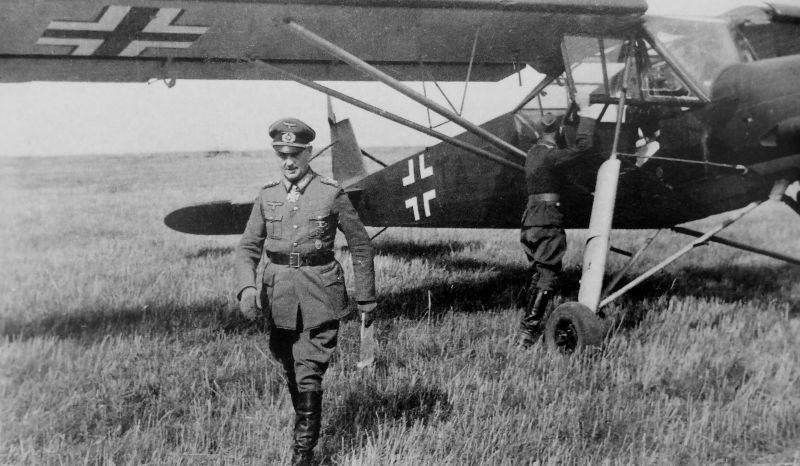
General Walter Model beside his "Stork"
For work in the desert, Fieseler has developed several interesting options designed specifically for work in difficult conditions. In addition to anti-dust and anti-sand filters, the "desert" aircraft received a large unglazed hatch on the right side of the fuselage, which greatly facilitated the loading and unloading of the wounded.
And in series "e" "Stork" became ... caterpillar!
Yes, for use on airfields with poor soil quality, a very interesting version of the aircraft with the original landing gear was developed. Each landing gear had two independently suspended wheels in tandem one after the other with a rubber tubular track stretched over them. Unfortunately, I could not find a photo, only a description.
This caterpillar was supposed to increase the area of contact of the landing gear with the ground and exclude the aircraft nosing when it hits an unnoticed furrow, pothole or stone. With this chassis, a test setup series of 10 Fi.156e-0 units was produced.
The plane was in demand. Despite the fact that the Fieseler plants were fully loaded with the Bf.109 output, the Fi.156 output also grew. In order to meet the needs of all those interested in "Aist", the release was organized at the former factories "Moran-Saulnier" in France and at the "Mratz" factory in Czechoslovakia.
The peak of Fi.156's career was the rescue in 1943 of Italian dictator Benito Mussolini by a group of thugs led by Otto Skorzeny.
Mussolini, after surrender, was accommodated in a hotel on the peak of the Gran Sasso Massif in Abruzzi Molise. The hotel was located at an altitude of 3000 meters, it was only possible to reach it by cable car, which, of course, was well guarded.
On the personal instructions of Hitler, a dizzying operation was developed with the use of paratroopers on gliders, who were supposed to interrupt Mussolini's guard (250 people) and free him.
They planned to take out the Duce on a Focke Achgelis Fa.223 "Drache" helicopter designed by Heinrich Focke (the same one who was "Focke-Wulf"), but the helicopter broke down as luck would have it.
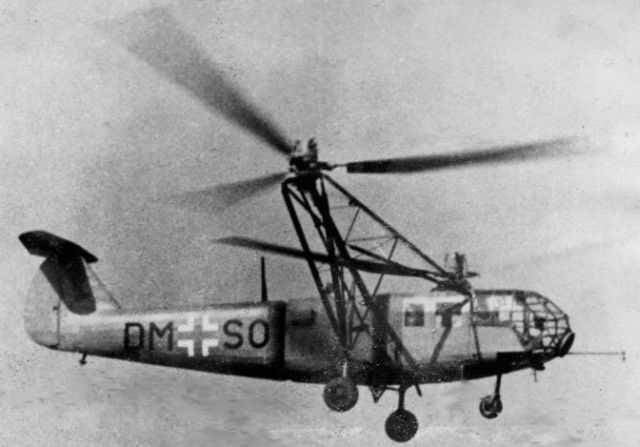
Well, here came the finest hour of Captain Gerlach and his "Storch". Mussolini and Skorzeny (who did not want to leave with his soldiers on their feet) were taken from a small area in front of the hotel. Yes, two such wild boars as Otto and Benito, and even in the highlands - it was a serious task. But "Aist" coped with "excellent".
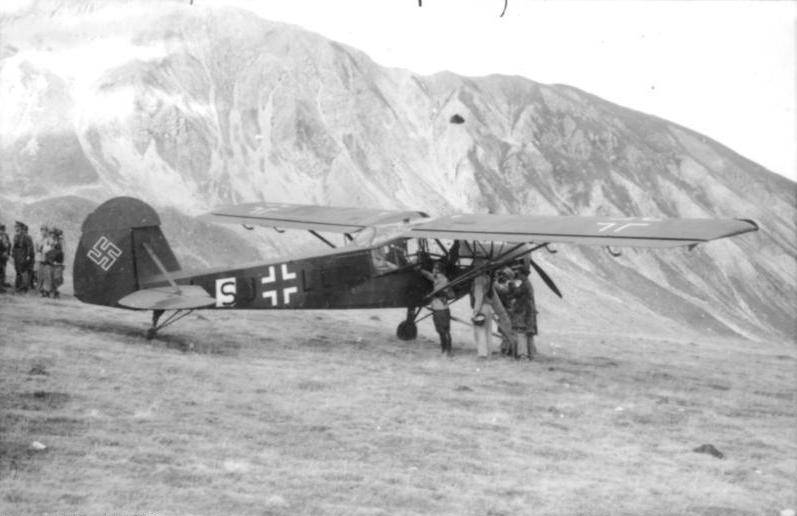
However, this special operation was one of a kind. Basically, "Storks" sat on no less difficult sites, but for the sake of simpler characters. But they did it massively and easily.
The production of Fi.156 for the needs of the Luftwaffe continued until August 1944. Then they began to curtail production for the sake of the fighter program. However, for all the time, 2900 aircraft of all modifications were produced, about 300 of which served with the allies of Germany.
Interestingly, Fi.156's career did not end with the end of the war. Since the equipment remained at the factories, the plane was quite in demand, so after the war the Morane-Saulnier MS-501 "Criquet" from France and the Czech Mráz K-65 "Čap" appeared in the sky.
As they say, find the difference.
We can say that "Aist" is an analogue of our Po-2. At least, he performed the same tasks for the Luftwaffe as the Po-2 in the Red Army Air Force, only he did not try himself as a float seaplane, unlike our airplane.
The fact that Gerhard Fieseler got an excellent plane is understandable. In general, Fieseler, by the way, was a very good pilot, participated in the First World War, shot down 19 enemy aircraft and was a recognized aerobatics ace. So it is understandable that with such luggage the plane turned out to be very interesting.
Lightweight, nimble, easy to control. And if we add the fact that the Aist had no problems with transportation ... The fact is that the wings of the Fi.156 could be folded along the fuselage, and the plane could either be transported on a railway platform in a “combat” state, nothing more without disassembling, or… simply tow it with a tractor along the road.
The aircraft, of course, is conditionally combat, but its outstanding data and participation in the war allow us to give it its due in our cycle.
LTH Fi.156c-2
Wingspan, m: 14,25
Length, m: 9,90
Height, m: 3,05
Wing area, м2: 25,20
Weight, kg
- empty aircraft: 930
- normal takeoff: 1 325
Engine: 1 x "Argus" As-10-C3 x 240 hp
Maximum speed, km/h: 175
Cruising speed, km / h: 150
Practical range, km: 385
Maximum rate of climb, m / min: 280
Practical ceiling, m: 4 600
Crew, prs: 2
Armament:
- one 7,92 mm MG.15 machine gun in the rear of the cockpit
- depth charge 135 kg or 3 bombs of 50 kg
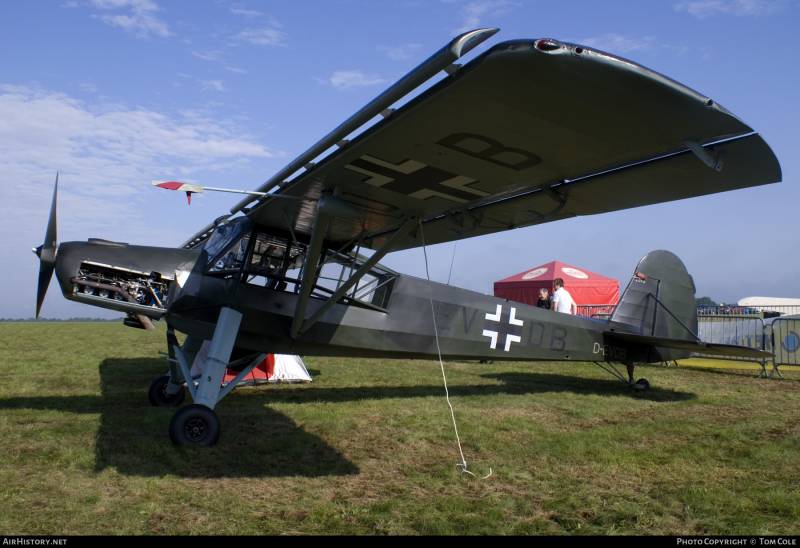
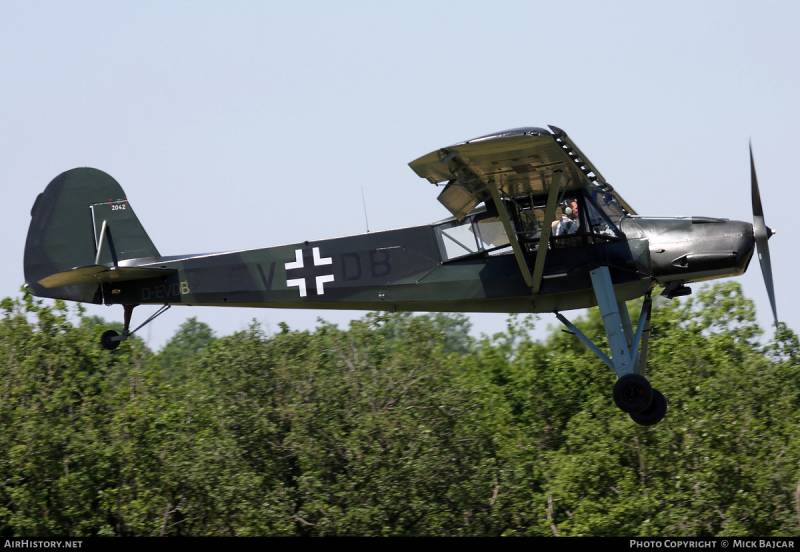
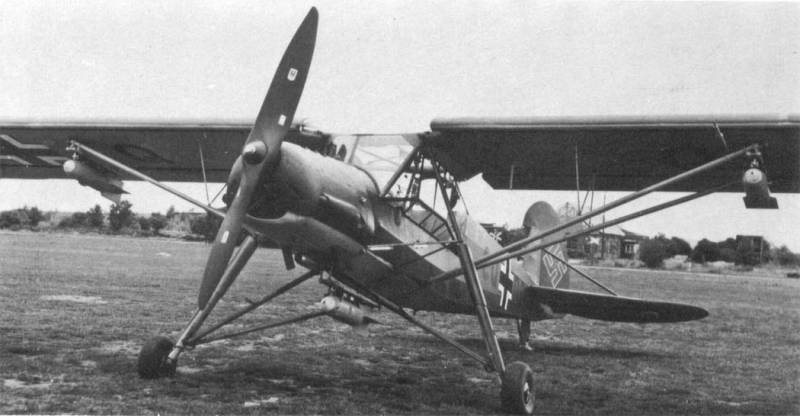
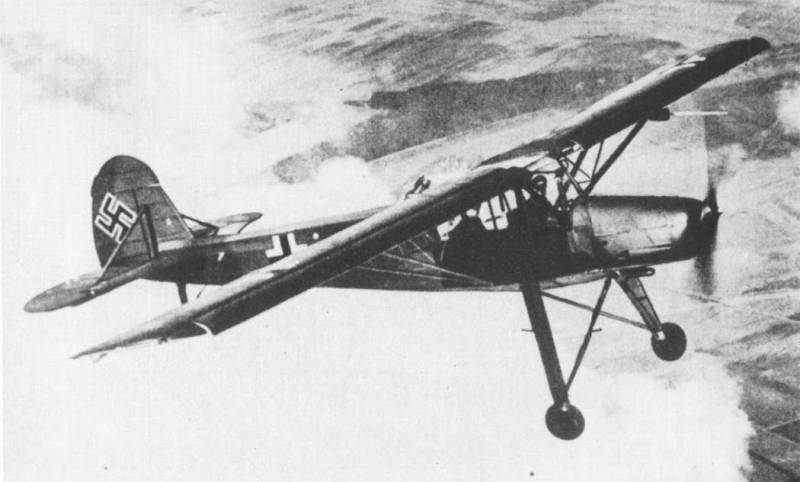
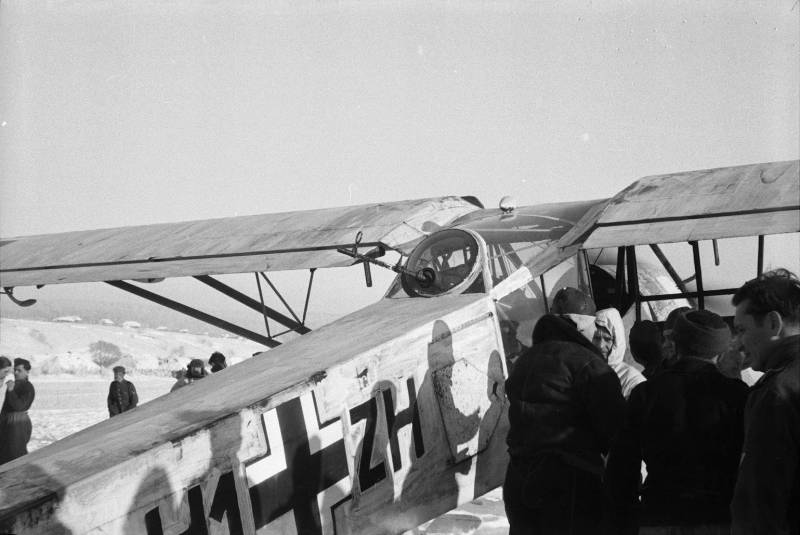
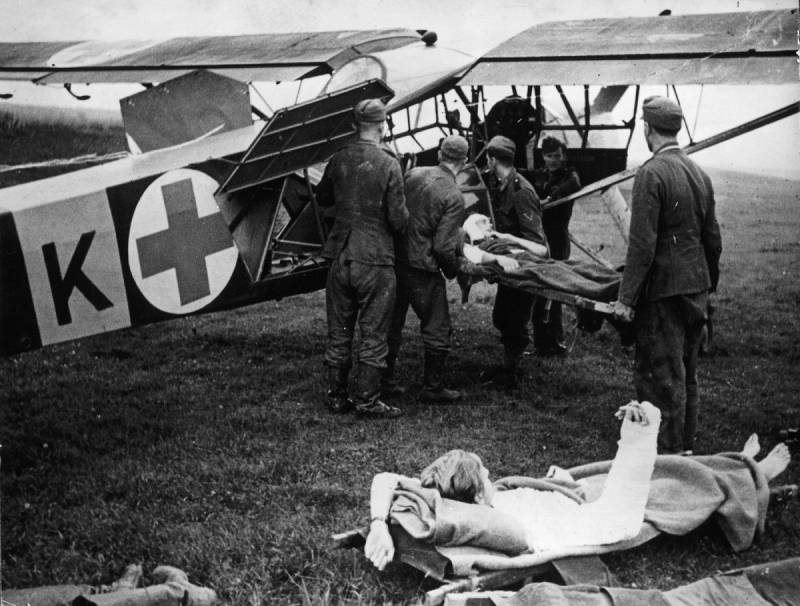
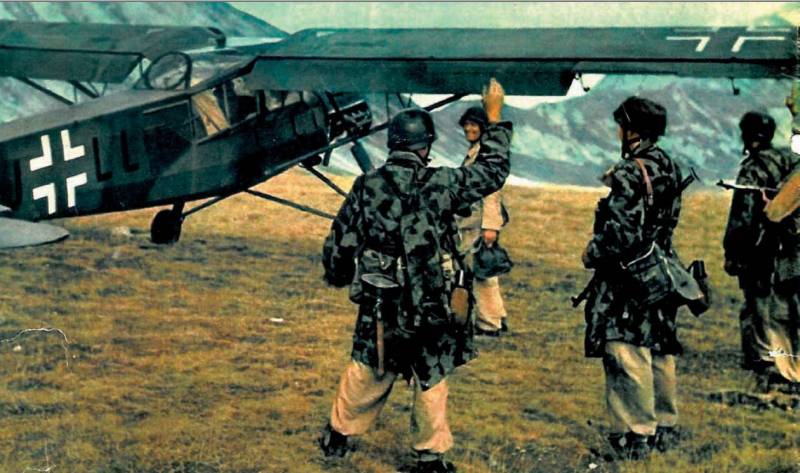
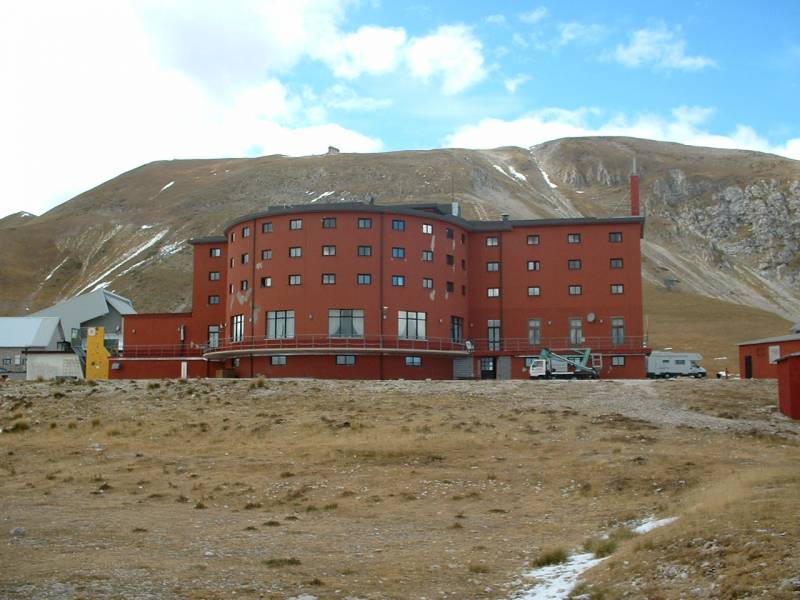
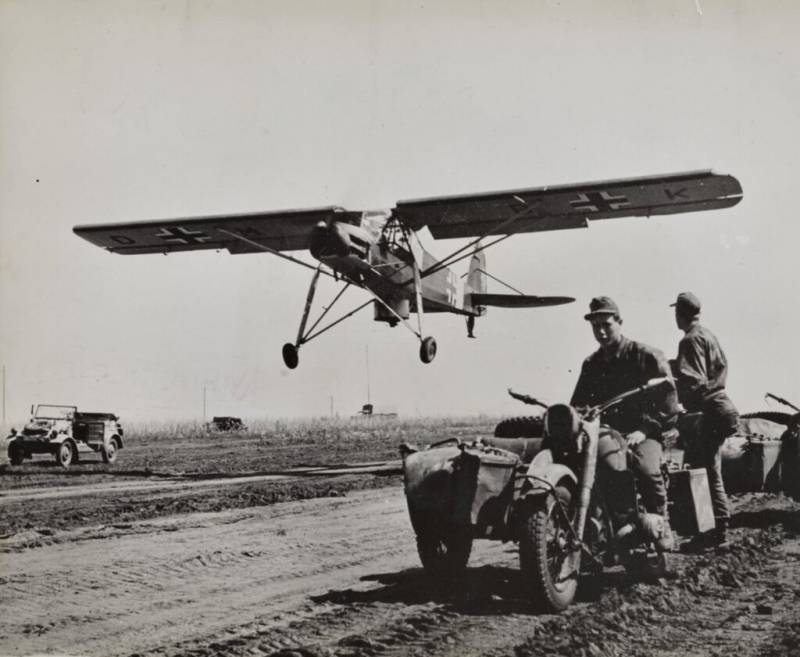
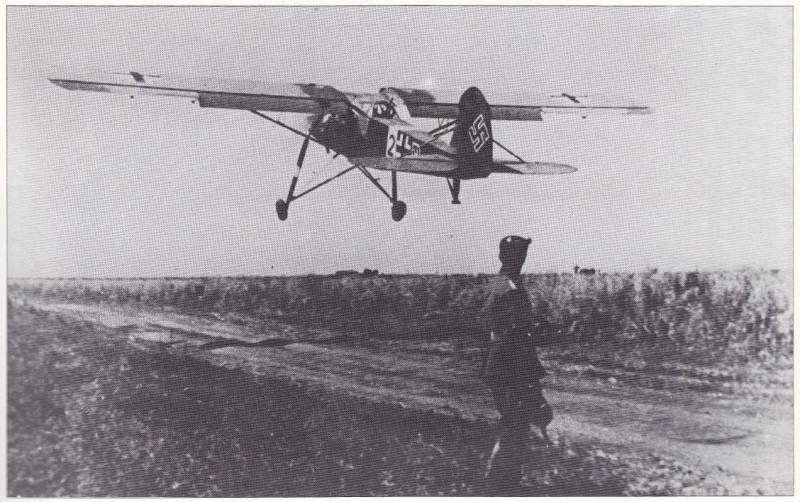
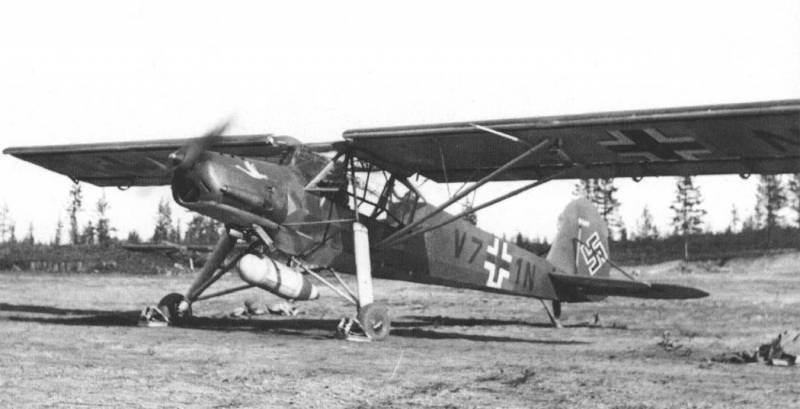
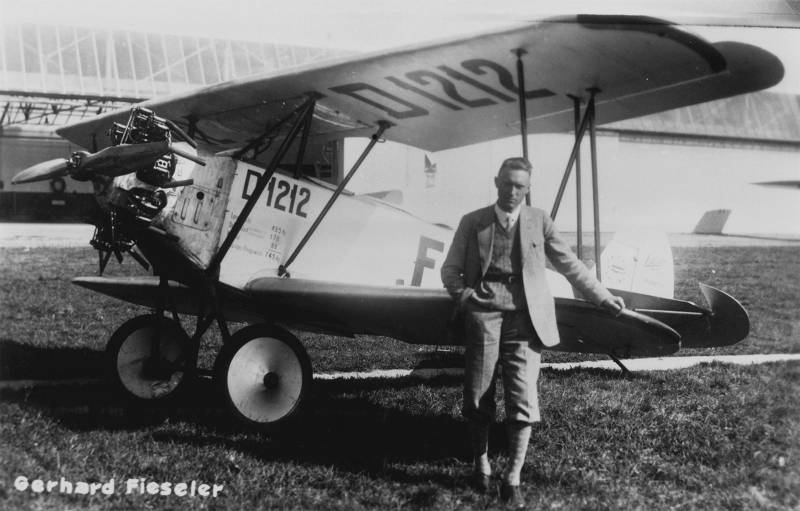
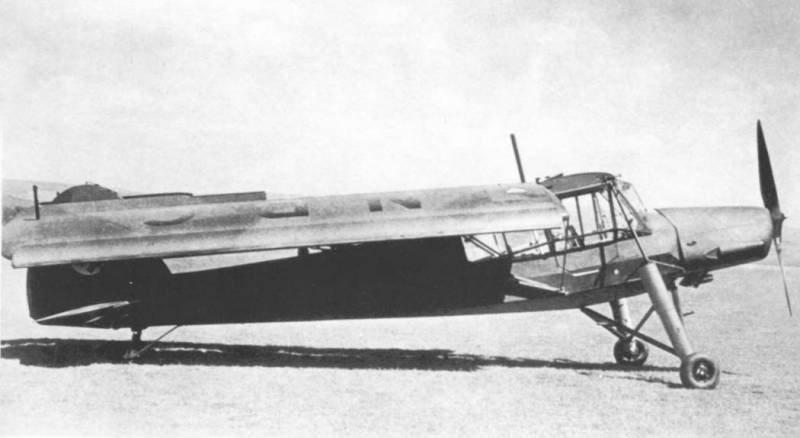
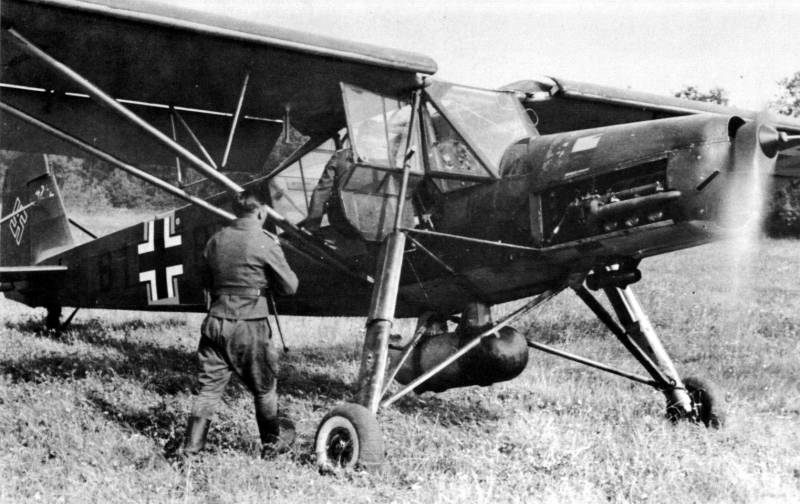
Information